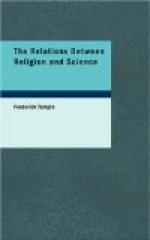And, in the second place, we have no right to expect that the evidence for miracles wrought in one age should be such evidence as properly belongs to another age. It is sometimes urged that the evidence supplied by the testimony of the early Christians is of little value because it was never cross-examined. No such precautions surrounded the evidence as would now be required to give any value to evidence of similar events. The witnesses gave up their lives to attest what they taught; but there was no one to scrutinise what they asserted. St. Paul’s evidence on our Lord’s Resurrection cannot now be put to the test of searching questions. But to make such objections as these is to make what is on the face of it an absurd demand. It is to ask that the scientific processes of the nineteenth century should have been anticipated in the first, that men should be miraculously guided to supply a kind of evidence which would be utterly superfluous at the time in order to be convincing eighteen hundred years afterwards. This would indeed have put the miraculous incidents in the New Testament narrative altogether out of place, and made the miracles more important than the Revelation which they were worked to introduce.
Now, if these two conditions are borne in mind, it is difficult to see what better evidence could be obtained of a miraculous life than we possess concerning the life of our Lord.
The moral and spiritual evidence is His own character which intentionally overshadows all the rest, and it is inconceivable that He should have made a false claim. And the material evidence is the testimony of men who freely gave their lives in proof of what they said. Nor has anything yet been said or written to shake Paley’s argument on this point.
But, if we pass on to the other objection, that no evidence can ever be sufficient to prove a miracle because the evidence for the uniformity of nature is so overwhelming, we can only see in such an assertion an instance of that inability to get out of an accustomed groove against which Science has perpetually to guard. In Science the uniformity of nature is so indispensable a postulate, that without it we cannot stir a step. And if the student of Science is to admit a breach, it can only be by stepping outside of his science for the time and conceiving the possibility that there is some other truth beside scientific truth, and some other kind of evidence beside scientific evidence. We have all heard of the need of guarding against the bondage in which custom binds the mind. We have heard of the student who when first he saw a locomotive looked perseveringly for the horses that impelled it, because he had never known, and consequently could not imagine any other mode of producing such motion. But this danger attends not only the separate investigations which Science makes into phenomena; it attends Science as a whole. And it is necessary repeatedly to insist on the fact that Science has not proved and cannot prove that the scientific domain is co-extensive with nature itself.




